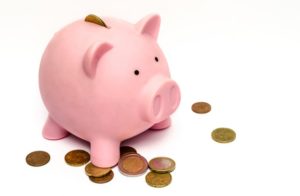Let’s Begin
You might be thinking that it’s too hard to save or that retirement is so far away that you can worry about it another day. But the truth is, the sooner you start saving, the greater the benefits you’ll see down the road. It’s easier than you might think. And chances are, you’re saving less than you should. The blog NerdWallet reports that the “Average American saves less than 5%” while the recommendation is to save 10-15% of your disposable income.
I used to live paycheck to paycheck. Each month, I worried about my bills and trying to make a dent in my student loan and credit card debt. I didn’t feel like saving for retirement (or saving at all) was really an option, especially since it was so far away. That was something that I could worry about later. Or so I thought.
With a little help from Meredith (MerNe), I was put right on track, and it was easier and faster than I would have thought possible. I went from having a lot of debt and a negative net worth, to being debt free and having an ever-growing net worth. I won’t lie, it does require a bit of work, but if you can keep up, it’ll be well worth it in the long run. Here are some tips for getting started.
Tracking Your Finances
The first step to getting on track is to know how much money is coming and how much is going. This helps, not only how much money you have available, but what you’re spending it on. At the most basic level, this is important so you KNOW where your money is going and how much is available for saving. Meredith has a good post that talks about the benefits of tracking your expenses. If you would like more info about that, you can check it out here.
So, how do you track your finances? The important part is that you have a single place where you can look and see all the money coming and going. If you track all your transactions as they occur, it makes it much easier to see what’s going on at any given time. Meredith and I like to use Google Sheets for all of our tracking needs. This lets us be as flexible as we want with what and how we track. It also lets both of us edit the spreadsheet from anywhere since it lives in the cloud. If the idea of spreadsheets is way too daunting for you, Mint.com is a popular service that you can use for free. You just link your various accounts to it, and Mint does the rest. It even helps you create a budget which we’ll talk about next.
Create a Budget
Now that you know how much money you have to spend on a monthly basis, and what you’re spending it on, you can begin to build your budget. This is something that you may need to adjust as time goes on, so don’t be nervous about picking the wrong numbers for each category. I suggest being conservative at first and give yourself some wiggle room. Make sure you have all your bills covered, and then make buckets for anything else, like eating out or clothes shopping. Whatever you notice that a good portion of your money goes to. Then create a catch-all “Other” category.
Here is where we start talking more about saving. Do you have a bucket called “Savings”? Do you need to create one? Well, now that you can see how much you’re spending compared to how much you’re earning, is there anything left over from month to month? That left-over cash can become your new “Savings” bucket. This is also a good opportunity to see if there’s any places you could reduce spending, such as eating out. You can check out this post, “Budgeting 101” for more information on keeping your budget.
Start Saving
Emergency Fund

The next question is, “Where do I put this money?” For starters, I would suggest starting an Emergency Fund if you don’t already have one. An Emergency Fund should be savings of 8-9 times your required monthly expenses. In other words, save up enough so that should something happen like the loss of a job, you could still pay your bills for 8-9 months. I suggest starting with this or some other savings of fluid money, so that when an unexpected large expense comes up, you don’t have to increase any existing debt to cover it.
Imagine, your refrigerator breaks and you have to buy a new one. Wouldn’t it be nice to have the money to replace it instead of piling it onto a credit card? Now, as a general rule, your emergency fund is there so you DON’T touch it, but as you start building your savings, it’s better to use that to replace a broken fridge than to add to your debt. It sort of counts as an emergency after all. To avoid having to dip into our emergency fund, we set up other savings buckets such as a “House Fund.” These buckets can exist completely in your budget, or you can create separate savings accounts for each one. Whatever you feel most comfortable with.
401k
What about retirement investments? Remember, the sooner you can start saving, the greater the rewards will be later on. Even a little bit of savings early on can start earning compound interest and put your money to work for you. The easiest way to start your retirement savings is if your company offers a 401k. This allows you to automatically have savings taken out of each paycheck without you even having to think about it. Some companies will enroll their employees automatically, but there’s still some work you should do on your end to get things set up, particularly if your employer offers a match on your contributions. If so, you’ll want to log on to your 401K account, and increase your contributions to the max that your employer will match. Set it and forget it.
Roth IRA
Have any money left to save? Maybe you should think about a Roth IRA. This is where some people start to go cross-eyed when presented with all the different options. I’m here to tell you that it’s not as complicated as it seems. I felt a little overwhelmed at first, but with a little bit of guidance, it’s a piece of cake. We use Vanguard.com for this. The easiest and probably safest fund to set up is an Index fund. I’m currently invested in the “500 Index Fund.” To get started, you will need at least $1000-3000 saved up since that is the minimum initial investment required by Vanguard. Save up in a basic savings account until you have enough, and then open up that Roth IRA! You’ll get much better returns on your money than you would keeping it in a savings account. And there’s many other benefits to saving in a Roth IRA. I would encourage you to research this further, check out Meredith’s Retirement 101 post to learn more.
Let’s Review!
You’re tracking your finances. You’ve created a budget. You’re saving your money. Congratulations! But you’re not done. Every once in a while, review your budget to see how well you’re staying under, or how often you’re going over. Remember, you’ll need to make adjustments as you go. It’s also a good idea to track your net worth every month. This is simply a calculation of all the money you have in savings, minus all your debt. At the very least, tracking this on a monthly basis will give you a good indicator on how you’re doing financially.
Additionally, for me, it’s very interesting to look back and see the progress I’ve made from having a negative net worth to being positive and continually growing net worth. To help with the progress, any time you get additional money from a side hustle or other source, consider putting all or most of it towards eliminating your debt/increasing your savings. You’ll begin to get excited to see that net worth go up!








